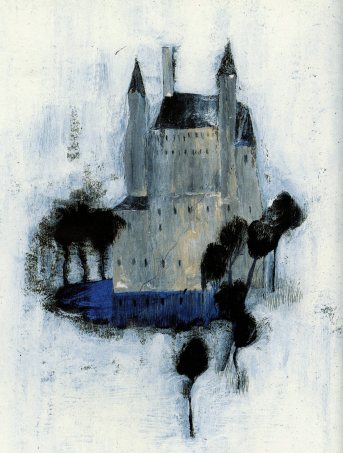*Click each image to view full size
Remember how I said I was going to feature a new illustrator each week in the run-up to the Hans Christian Andersen Award announcement in March? Well, I sort of lost track over the holidays. But I still have tons of gorgeous illustrations saved on my computer that are aching to be shared with a small slice of the Internet.
This week, I’m focusing on the work of Belgian illustrator Carll Cneut. Like many of the well-regarded illustrators in the world of children’s literature, Cneut received formal artistic training at the Institute of Fine Arts of St. Luke in Ghent. Also like many illustrators, Cneut worked in a different field–in his case, advertising–before he was able to devote himself full-time to children’s literature. But we–and children–are very lucky that he eventually did!

Many of Cneut’s illustrations feature lonely characters staring forlornly at a full moon, such as in Heksenfee (“Witchfairy”), above. The fairy in question, Rosemary, is tired of being good and instead dreams of becoming a witch. When she starts behaving badly, however, her mother disowns her. Suffice it to say that it’s a tale of independence with lots of parental troubles thrown in.

The cover of Het geheim van de keel van de nachtegaal (“The secret of the nightingale’s throat”) is similar in style and setting. A young boy’s sad silhouette is etched against a gleaming moon and silky blue-black darkness. There’s a prevalent sentiment that children in their natural state are happy, but Cneut’s illustrations give children credit for being multidimensional, capable not only of naive jubilance, but also detachment and melancholy. (You can read the original story by Hans Christian Andersen here).

Even more disturbing are the illustrations in De blauwe vogel (“The Blue Bird”). I remember reading a version of this story as a kid–it’s a classic French (or Russian?) fairy tale full of romance and deception. In this version, a desperate mother has to travel to the Land of Memories in an attempt to save her daughter. I can’t read Dutch, but the Land of Memories is, I presume, the setting of the image above. Ghosts, black cats, fire spirits, walking teacups, wolves, and mobile bags of sugar–De blauwe vogel has all manner of bizarre creatures.

My favorite of Cneut’s drawings come from an illustrated anthology of Edgar Allan Poe stories. What can I say apart from the fact that they are marvelous? The decaying man on the cover is certainly frightening, as is the hazy castle with its crooked black trees and dreamlike, amnesiatic atmosphere.

Last is the blurry gathering of a skeleton, a pumpkin-head, ghouls and goblins and other chimerical creations in a darkened room with falling light, as though Cneut discovered a photographic negative and decided to fill it in with blues and grays, keeping the original fully & fantastically intact.

To view the work of the other artists in this series, just click the “Children’s Literature” link in the right sidebar.
